Ata-ul-Haye Nasir, Ahmadiyya Archive & Research Centre

In the last 100 years, the Fazl Mosque in London has hosted various receptions attended by dignitaries from all walks of life – from religious circles to the worldly spheres. These receptions would be held to mark certain occasions such as the Eid-ul-Fitr and Eid-ul-Adha.
Though the London Mission had been hosting the Eid gatherings even before the foundation of the Fazl Mosque, the 1925 Eid-ul-Fitr possesses a special significance, as it was the first Eid prayer offered at the premises of the Fazl Mosque since its foundation that was laid in October 1924 by Hazrat Musleh-e-Maudra.
In addition to presenting a glimpse of the press coverage received by this historic Eid-ul-Fitr in 1925, the article aims to highlight the press coverage of the later years’ Eid gatherings at the Fazl Mosque – from 1925 to 1955. The 1955 Eid-ul-Adha was the first-ever Eid led at the Fazl Mosque by a Khalifatul Masih.
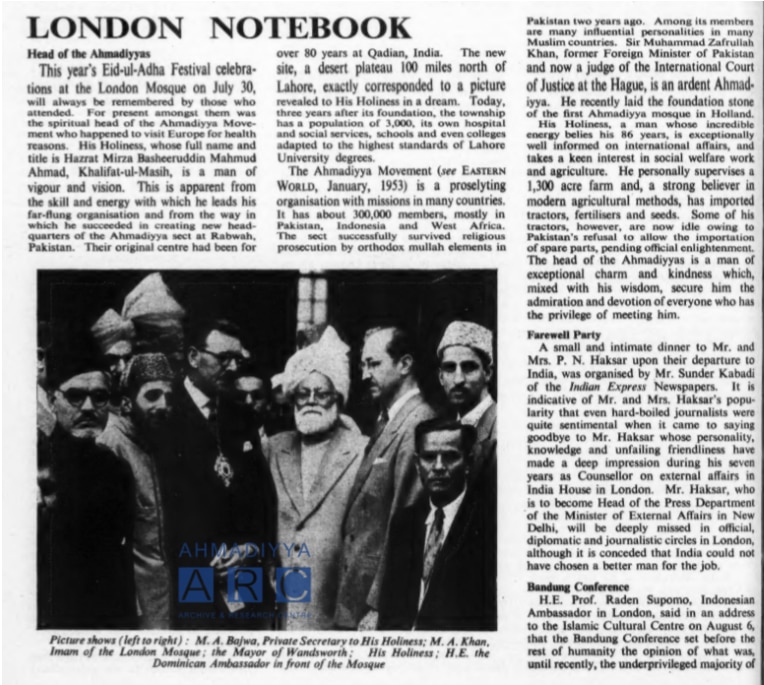
1925: First Eid since the Fazl Mosque’s foundation
The historic Eid-ul-Fitr of 1925 was covered by multiple periodicals of England, Canada and America, along with photographs. The Sunday Pictorial of 26 April 1925 wrote, “For the first time the ‘Happy Feast’ of Islam Eed-Ul-Fitr, was celebrated yesterday, on the chosen site for the first mosque in London, at Melrose-road, Southfields.”
The Evening Standard of 25 April 1925 reported under the heading “Cairo in London: Picturesque Scenes at Moslem Service” and The Daily Express of 27 April 1925 reported under the heading “Prayers in a Garden”.
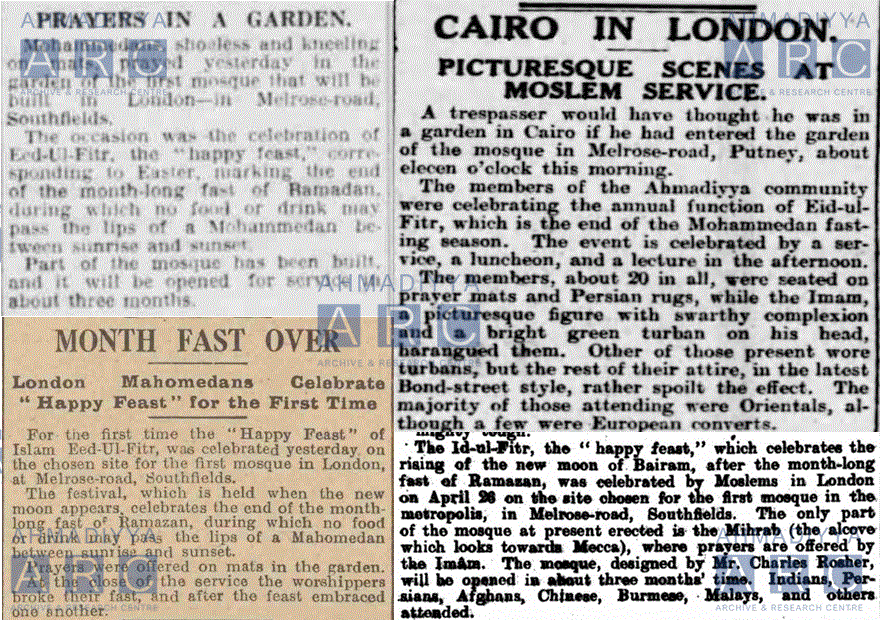
Multiple American and Canadian newspapers reported on this Eid-ul-Fitr gathering, along with photographs. For instance, The Saskatoon Phoenix published a photograph on 21 May 1925 with the caption, “In Constantinople, commonplace, but in London, novel. Members of the Ahmadiyya Community at prayer on the grounds of the new London Mosque, during the recent celebrations of Eid.” St Louis Globe-Democrat of 24 May 1925, The Toronto Daily Star of 16 May 1925 and The Leader of 21 May 1925 also published photographs. The most detailed report was published by the South Western Star of London on 1 May 1925, under the heading “Islam at Southfields”.
Ten weeks later, the first Eid-ul-Adha was offered at the proposed Fazl Mosque’s premises in July 1925.
1926-1927: Eid-ul-Fitr and Eid-ul-Adha
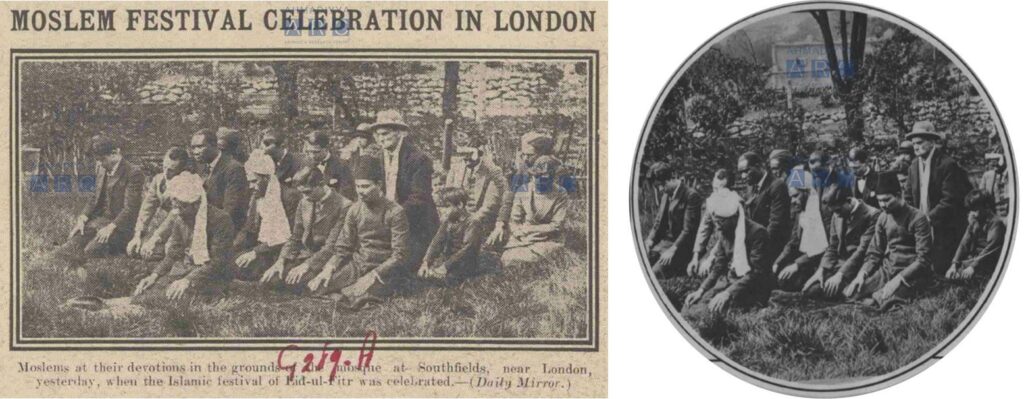
Reporting on the 1926 Eid-ul-Fitr, The Daily Mirror of 15 April 1926 published a photograph with the caption, “Moslems at their devotions in the grounds of the mosque at Southfields, near London, yesterday, when the Islamic festival of Eid-ul-Fitr was celebrated.” The Daily Herald of 15 April 1926 and Diario de la Marina of 23 May 1926 also published photographs.
Capturing a moment at the 1927 Eid-ul-Adha, The Sphere of London, dated 25 June 1927, published a photograph with the caption, “The Mecca of London: The embracing ceremony which ends the Moslem festival of Eid-ul-Azha, in which many Mohammedan Londoners took part. The Imam of the London Mosque Mr. A. R. Dard, is on the extreme right.” The Jewish Missionary Magazine gave news about this gathering by quoting an excerpt from The Palestine Weekly. The Evening Despatch of 11 June 1927 and South Western Star of 17 June 1927 also published a report.
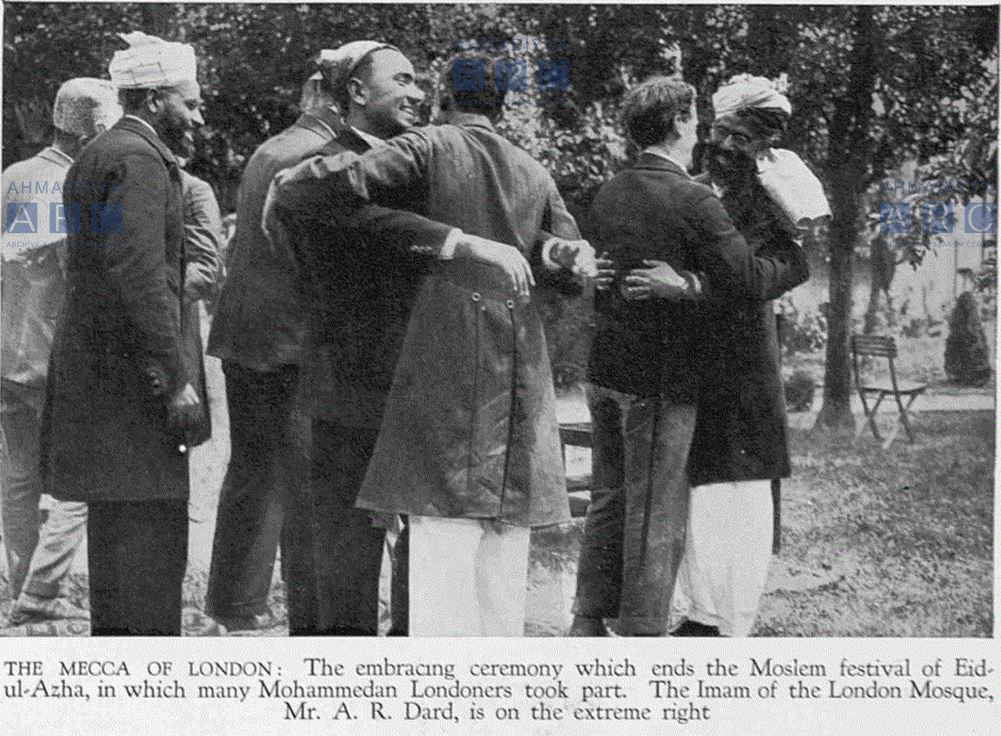
1928: Viscount Allenby at the Eid-ul-Adha reception
On 31 May 1928, the Eid-ul-Adha reception was attended by various dignitaries including Viscount Allenby (1861-1936) – a senior British Army officer and Imperial Governor, and Sir E Denison Ross (1871-1940) – an orientalist and the first Director of the School of Oriental Studies (now SOAS) London. The Daily Mirror of 1 June 1928 published a photograph with the following caption:
“Field-Marshal Viscount Allenby and Viscountess Allenby arriving at the London Mahomedan Mosque at Southfields yesterday for a garden party, and welcomed by the Imam (priest), Mr. A. R. Dard.”
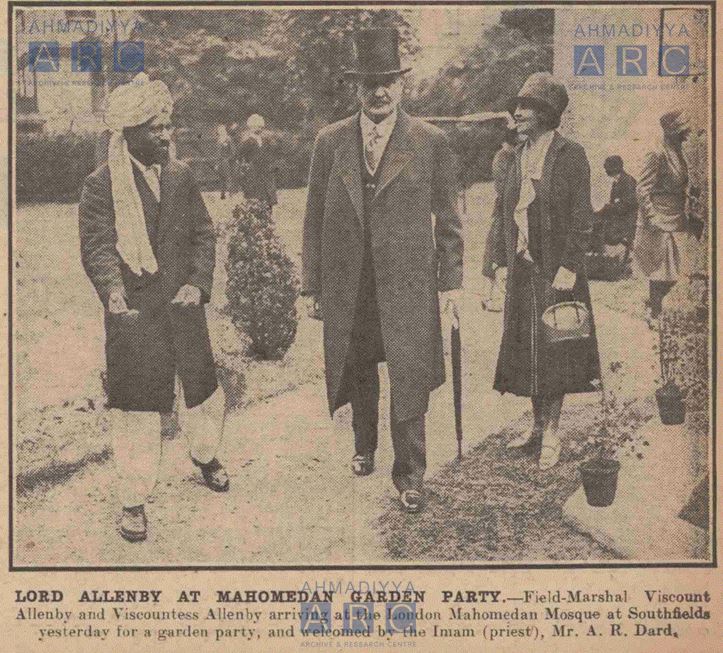
The Scotsman of 1 June 1928 reported under the heading “Moslem Festival in London: Lord Allenby Present” and The Palestine Bulletin of 25 June 1928 also published a detailed report. The Sunday Mercury of 3 June 1928 published an interesting story as it states, “A number of M.P.s and their wives attended a garden party at the London mosque one day this week in celebration of a Mohammedan festival, and the Imam or priest who received them surprised and even offended the ladies by refusing to shake hands with them though he did so with all the men visitors. Later he explained that it was against his religion to shake hands with women.”
1929: Sarojini Naidu and Maharajah of Burdwan at the Eid-ul-Adha reception
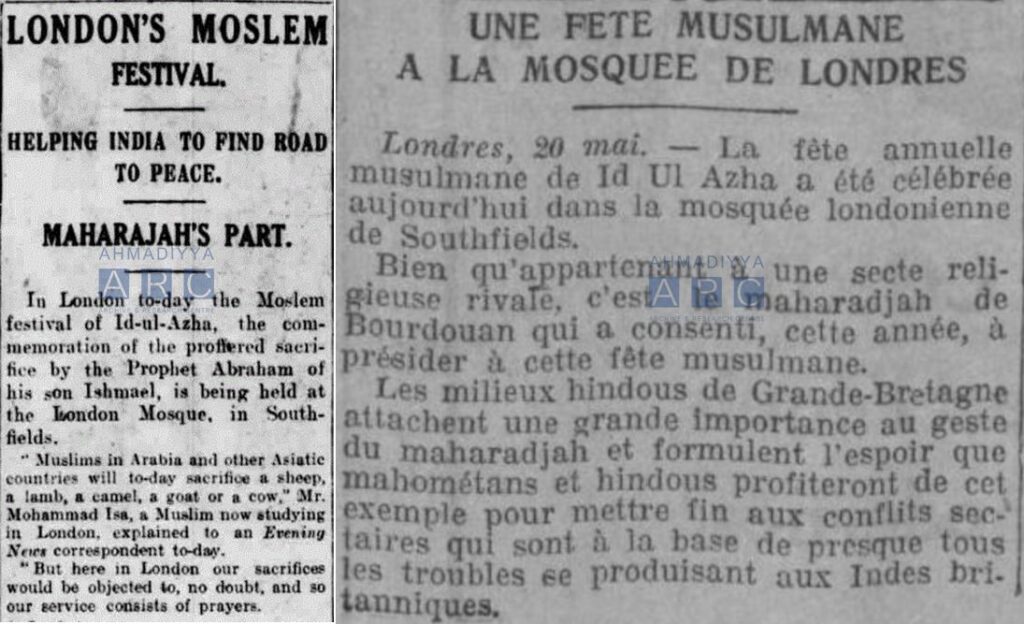
On 20 May 1929, the Eid-ul-Adha reception was attended by the Maharajah of Burdwan – Sir Bijay Chand Mahtab (1881-1941), and Sarojini Naidu (1879-1949) – an Indian political activist who served as the first Governor of United Provinces, after India’s independence.
A French newspaper, L’Homme Libre of 21 May 1929 reported under the heading “A Muslim Festival at the London Mosque” and stated that with the Maharajah of Burdwan presiding over the reception, both Muslims and Hindus will take advantage of this example to put an end to the sectarian conflicts that lie at the root of almost all the unrest occurring in British India.
The South Western Star of 24 May 1929 declared “the presence of these prominent Hindus at a Moslem festival in London” a “unique” event.
According to The Norwood News of 17 May 1929, an invitation was sent to the Balham Rotary Club as well. The Evening News of 20 May 1929 gave details of this reception.
1930: Sir Francis Younghusband presides the Eid reception
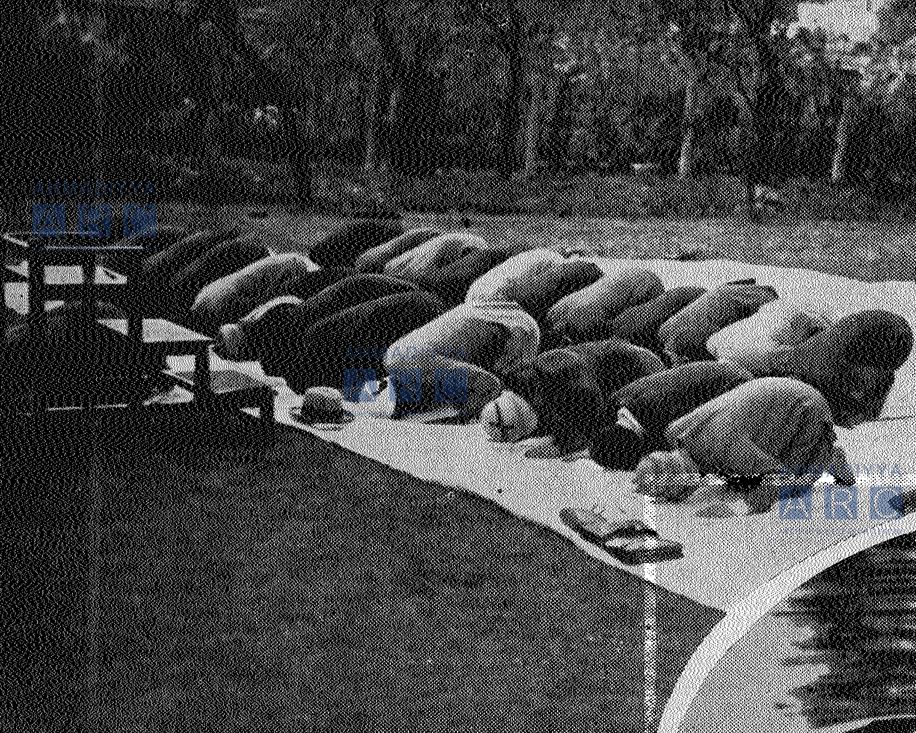
The 1930 Eid-ul-Adha reception was attended by various dignitaries, including Sir Francis Younghusband (1863-1942) – a well-known orientalist of the 20th century.
The Christchurch Star of 28 June 1930 published a photograph with the caption, “The Moslem Festival of Id-ul-Azha was carried out with customary ritual at the London Mosque at Southfields on May 9. Here are some faithful at prayer. They include a number of white women.”
The Labor Daily of Australia published the same photograph on 21 June 1930. The Civil and Military Gazette of 12 May 1930 reported under the heading “Id-uz-Zuha in London: Sir F. Young Husband at Wandsworth Mosque”. The Palestine Bulletin of 12 May 1930 also published a report.
1932: Eid-ul-Fitr
Mentioning the Eid-ul-Fitr in 1932, The Daily Telegraph of 17 March 1932 published a photograph with the following caption:
“Shoes lined up outside the Southfields Mohammedan Mosque, London, told that the faithful had entered to celebrate the feast of Eid-El-Fitr.”
1933: Jinnah at the Eid-ul-Adha reception
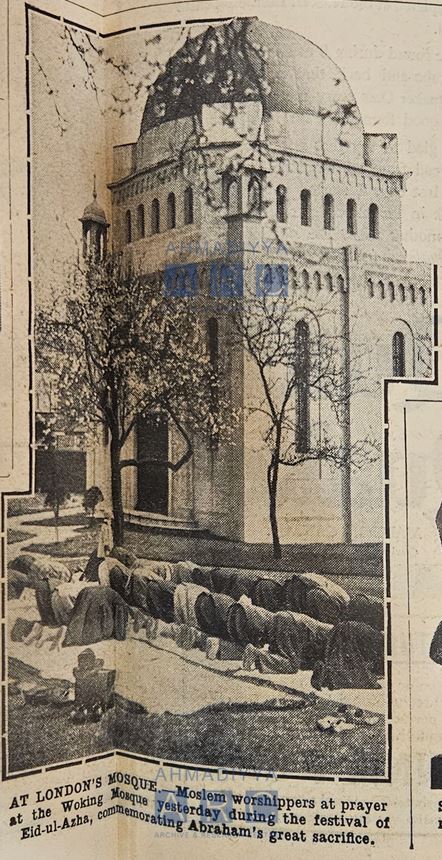
In April 1933, the Eid-ul-Adha reception was attended by various dignitaries including Muhammad Ali Jinnah (1876-1948), who was later known as the Founder of Pakistan.
The Daily Mirror of 7 April 1933 published a photograph of this gathering with the following caption:
“At London’s Mosque.–Moslem worshippers at prayer at the Woking [sic., Fazl] Mosque yesterday during the festival of Eid-ul-Azha, commemorating Abraham’s great sacrifice.”
During this reception, Jinnah delivered a speech on the future of India which attracted many newspapers of the British and Indian press, including The Statesman, Madras Mail, Hindu, Sunday Times, etc.
It is believed that it was after this reception that he decided to return to Indian politics and continue his strive for Muslim rights and later the formation of Pakistan.
1934: British MP presides the Eid-ul-Adha reception

Reporting on the 1934 Eid-ul-Fitr, The Western Mail of 22 February 1934 published a photograph with the following caption:
“Towards Mecca: Muslims at prayer inside the London Mosque, Southfields, during the celebration of a festival by the Muslim Society of Great Britain.”
On 27 March 1934, the Eid-ul-Adha reception was presided over by the Earl Winterton, P.C., M.P. The Eastern Post and City Chronicle of 10 March 1934 announced, “The Earl Winterton, P.C., M.P., will preside at the London Mosque on Tuesday, March 27th, on the occasion of the Moslim festival of ‘Id-ul-Azha, when Sir John Wardlaw-Milne, M.P., K.B.E., will speak on ‘British Empire and Islam.’”
The Evening Standard published an article on 28 March 1934, stating, “A friend of mine attended the celebration of the ‘Feast of Sacrifice’ at the London Mosque yesterday.” The Palestine Post also published a report in its 9 April 1934 issue.
1935: High Commissioner for India presides over the Eid-ul-Adha reception
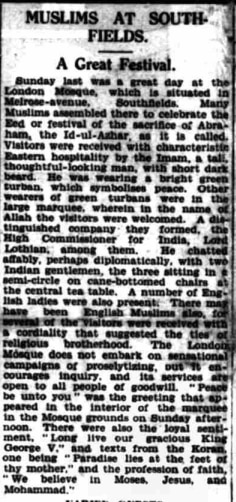
On 17 March 1935, Eid-ul-Adha reception was attended by various dignitaries, including Sir Francis Younghusband and presided over by the High Commissioner for India. Reporting on this, the South Western Star of 22 March 1935 wrote under the heading “Muslims at Southfields: A Great Festival”:
“The High Commissioner for India, who was in the chair, introduced Sir Francis Younghusband as a great explorer and one of the sincerest advocates of a better understanding between East and West. There was, he said, nothing more hopeful than the prevalence of religious tolerance. Religion might still be a stumbling block in politics, but no-one now believes it can be promulgated by violence.”
Towards the end, it wrote:
“The London Mosque has been founded and endowed by the Ahmadiyya Movement, the founder of which, Prophet Ahmad of Qadian (India) has been the most energetic and spiritual figure in the history of Islam since Mohammad. The foundation stone of the mosque was laid in 1924 by the Commander of the Faithful, the present head of the community, and the mosque was formally opened in 1926.”
1936: Lord Lloyd and LS Amery meets Hazrat Mirza Nasir Ahmadrh at Eid reception
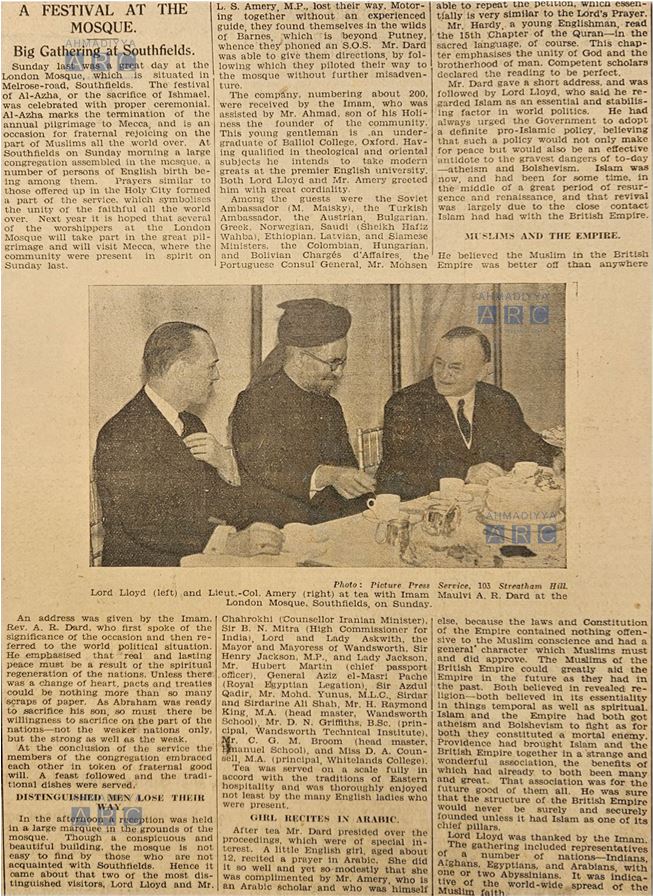
In 1936, an Eid-ul-Adha reception was held which was attended by LS Amery (1873-1955), the then-member of the British Parliament who later served as the Secretary of State for India and Burma in the 1940s. The dignitaries also included George Ambrose Lloyd (1879-1941), a British Conservative politician and colonial administrator.
The South Western Star of 13 March 1936 published a detailed report along with a photograph with the following caption:
“Lord Lloyd (left) and Lieut.-Col. Amery (right) at tea with Imam Maulvi A. R. Dard at the London Mosque, Southfields, on Sunday.”
The report was titled “A Festival at the Mosque: Big Gathering at Southfields” and stated:
“In the afternoon a reception was held in a large marquee in the grounds of the mosque. […] The company, numbering about 200, were received by the Imam, who was assisted by Mr. Ahmad [Hazrat Mirza Nasir Ahmadrh], [grand]son of his Holiness the founder of the community. This young gentleman is an under-graduate of Balliol College, Oxford. Having qualified in theological and oriental subjects he intends to take modern greats at the premier English university. Both Lord Lloyd and Mr. Amery greeted him with great cordiality.”
The Daily Telegraph of 9 March 1936, The Morning Post of 9 March 1936, The Times of 10 March 1936 and Edinburgh Evening News of 14 March 1936 also reported.
1937: Secretary of State for India at the Eid-ul-Adha reception
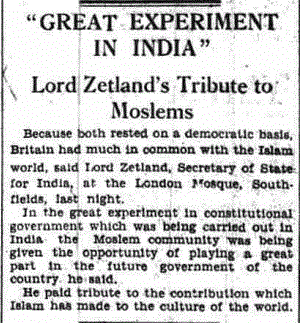
On 22 February 1937, an Eid-ul-Adha reception was presided over by Lord Zetland (1876-1961), the then Secretary of State for India.
The Yorkshire Post of 23 February 1937 reported under the heading “Great Experiment in India: Lord Zetland’s Tribute to Moslems”:
“Because both rested on a democratic basis, Britain had much in common with the Islam world, said Lord Zetland, Secretary of State for India, at the London Mosque, Southfields, last night.
“In the great experiment in constitutional government which was being carried out in India the Moslem community was being given the opportunity of playing a great part in the future government of the country, he said. He paid tribute to the contribution which Islam has made to the culture of the world.”
The South Western Star of 26 February 1937 reported under the heading “The London Mosque: Festival at Southfields”.
1938: Eid-ul-Fitr
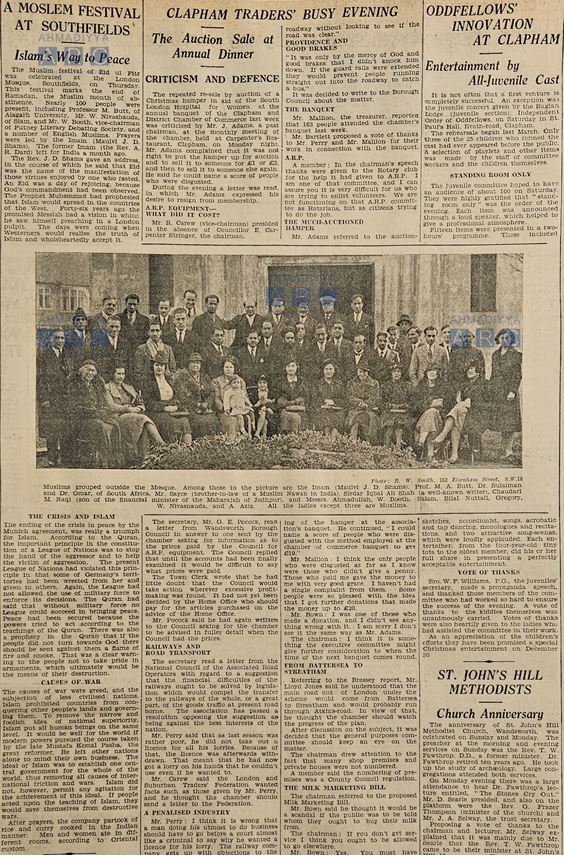
In 1938, reporting on the Eid-ul-Fitr reception, the South Western Star of 2 December 1938 published a photograph with the following caption:
“Muslims grouped outside the Mosque. Among those in the picture are the Imam (Maulvi J. D. Shams), Prof. M. A. Butt, Dr. Sulaiman and Dr. Omar, of South Africa, Mr. Sayce, brother-in-law of a Muslim Nawab in India), Sirdar Iqbal Ali Shah (a well known writer), Chaudari M. Naqi (Son of the Financial minister of the Maharajah of Jodhpur), and Messrs Ahmadullah, W. Booth, Salam, Bilal Nuttall, Gregory, W. Nivashauda, and A. Aziz. All ladies except three are Muslims.”
The article stated:
“The Muslim festival of Eid ul Fitr was celebrated at the London Mosque, Southfields, on Thursday. This festival marks the end of Ramadan, the Muslim month of abstinence. Nearly 100 people were present, including Professor M. Butt, of Aligarh University, Mr. W. Nivashauda, of Siam, and Mr. W. Booth, vice-chairman of Putney Literary Debating Society, and a number of English Muslims. Prayers were led by the Imam (Maulvi J. D. Shams). The former Imam (the Rev. A. R. Dard) left for India a month ago.”
1939: Eid-ul-Fitr and Eid-ul-Adha
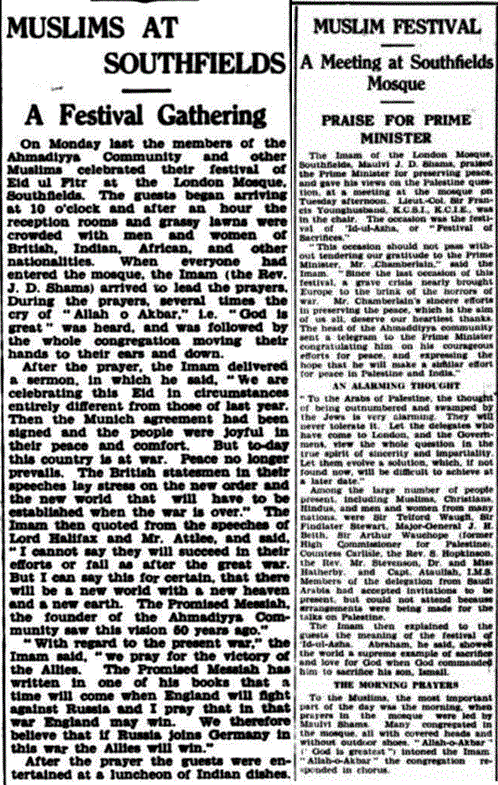
On 31 January 1939, Eid-ul-Adha reception was attended by various dignitaries. The South Western Star of 3 February 1939 wrote under the heading “Muslim Festival: A Meeting at Southfields Mosque”:
“Among the large number of people present, including Muslims, Christians, Hindus, and men and women from many nations, were Sir Telford Waugh, Sir Findlater Stewart, Major-General J. H. Beith, Sir Arthur Wauchope (former High Commissioner for Palestine), Countess Carlisle, the Rev. S. Hopkinson, the Rev. Mr. Stevenson, Dr. and Miss Hatherby, and Capt. Ataullah, I.M.S. Members of the delegation from Saudi Arabia had accepted invitations to be present, but could not attend because arrangements were being made for the talks on Palestine.”
On 13 November 1939, Eid-ul-Fitr was offered at the Fazl Mosque and the same newspaper, on 17 November 1939, reported it under the heading “Muslims at Southfields: A Festival Gathering”.
1940-1947: Various Eid gatherings at the Fazl Mosque
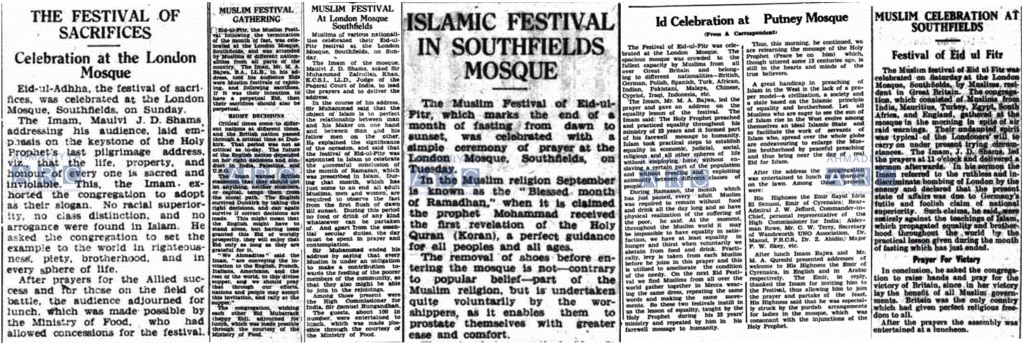
The Eid gatherings during the years 1940-1947 also caught considerable attention from the British press. Most prominent news reports were published by the South Western Star. For instance, the 1940 Eid-ul-Fitr was reported on 8 November 1940, under the heading “Muslim Celebration at Southfields: Festival of Eid ul Fitr”; the 1941 Eid-ul-Fitr was reported on 24 October 1941, under the heading “The London Mosque: Eid-ul-Fitr Celebrations”; the 1944 Eid-ul-Fitr was reported on 22 September 1944, under the heading “Islamic Festival in Southfields Mosque”; the 1944 Eid-ul-Adha was reported on 1 December 1944, under the heading “The Festival of Sacrifices: Celebration at the London Mosque” and the 1945 Eid-ul-Fitr was reported on 14 September 1945, under the heading “Muslim Festival at London Mosque Southfields”.
On the occasion of Eid-ul-Adha in 1945, Hazrat Maulana Jalal-ud-Din Shamsra spoke about the Palestine conflict and advised the British Government that “in making its decision, the Government should not however, overlook the fact that the inhabitants of Palestine had the right to rule themselves.” (Leicester Evening Mail, 17 November 1945, p. 5)
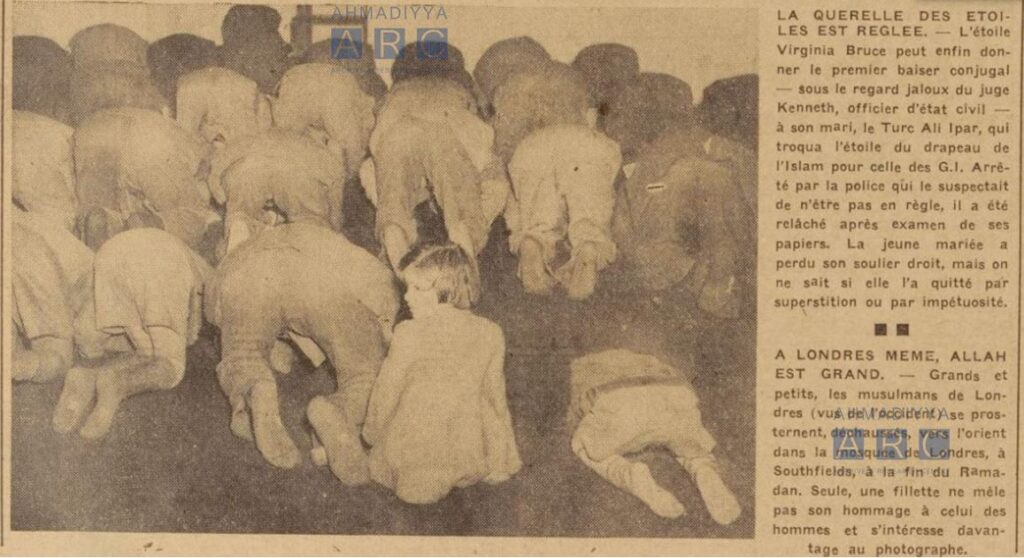
A French newspaper, France-soir of 4 September 1946, reported on the 1946 Eid-ul-Fitr and published a photograph. The South Western Star reported it on 6 September 1946, under the heading “Muslim Festival Gathering”.
The 1947 Eid-ul-Fitr reception was attended by various dignitaries, including a representative of the Mayor of Wandsworth. (South Western Star, 22 August 1947, p. 4)
1948: Delegates of the African Conference at the Eid reception
On 14 October 1948, Eid-ul-Adha was offered at the Fazl Mosque. In those days, an African Conference was taking place in England, hence, the African dignitaries attended an Eid reception at the Fazl Mosque.
Le Soir illustré of Belgium published a photograph capturing guests who had gathered for the reception, with the following caption:
“Presence of the Orient, in London – Maulvi Mohd. Siddique, representing the colony of Sierra Leone in the English capital (right), and the Emir of Abuja […] at the London Mosque, during the Eid-ul-Adha festival.” (Le Soir illustré, 21 October 1948)
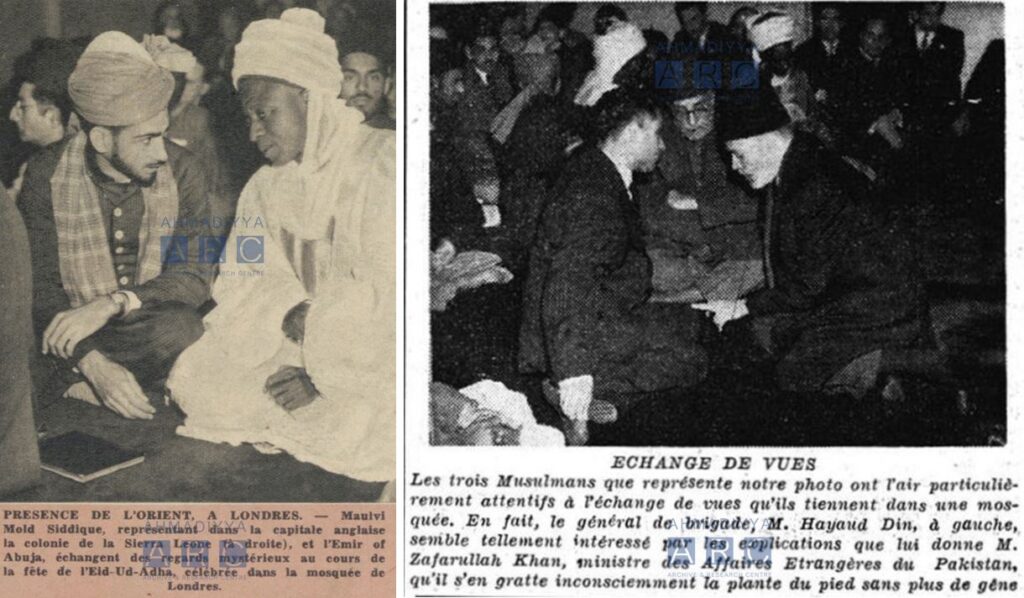
In the above-mentioned photograph, the 6th Amir of Abuja, Suleimanu Barau (1903-1979), is having a discussion with Maulvi Muhammad Siddique Sahib Amritsari.
L’Indépendance of Belgium – in its 1 December 1948 issue – published another photograph of the same event. The same photograph was published by Greymouth Evening Star of New Zealand on 8 November 1948 as well.
1949-1954: Various Eid gatherings at the Fazl Mosque
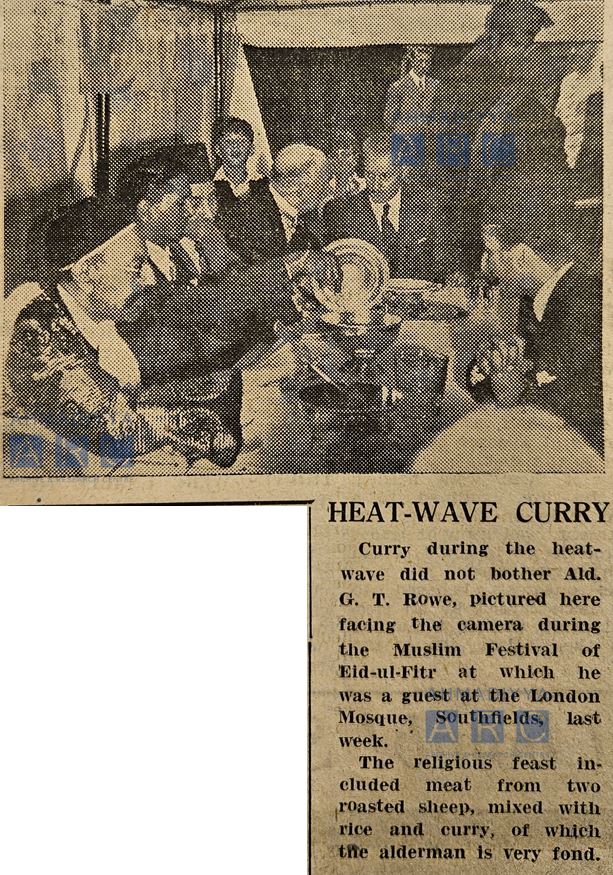
Reporting the 1949 Eid-ul-Fitr reception, the South Western Star published a photograph on 5 August 1949, with the caption, “Curry during the heat-wave did not bother Ald. G. T. Rowe, pictured here facing the camera, during the Muslim festival of Eid-ul-Fitr at which he was a guest, at the LondonMosque, Southfields, last week.”
The Civil and Military Gazette of 15 August 1949 published an article under the heading “Id Celebration at Putney Mosque”.
Reporting on the 1950 Eid-ul-Fitr reception, the South Western Star of 21 July 1950 wrote, “The present Imam, Mr. M. A. Bajwa, who has been in this country for five years, is returning to Pakistan and among those who paid tribute to his work in this country was Mr. Hugh Linstead, local Member of Parliament. The Mayor of Wandsworth, Cllr. R. W. K. Edgley, was also present.”
Reporting on the 1950 Eid-ul-Adha, the South Western Star of 29 September 1950 wrote:
“The Muslim Festival of Eid-ul-Adha (the Festival of Sacrifice), was celebrated at the London Mosque, Southfields,” and “after luncheon a meeting was held in which representatives of five different religions, including Mr. Shaw Desmond, the famous writer, paid tribute to the noble character of the Holy Prophet Muhammad.”
Reporting on the Eid-ul-Adha of 1952, The Manchester Guardian of 1 September 1952 wrote under the heading “At the London Mosque”:
“For Moslems everywhere this has been the day of Eid-ul-Adha – the celebration of the sacrifice by Abraham of his son Ishmael. It is a day for them to pray together and to eat together, and this some two hundred did at the London mosque in Wandsworth. Cream painted, with a dome of streaky turquoise, the mosque is a rare shell thrown up from the East on a beach of English terraced houses. Turks and Africans, Egyptians and Indians, and Pakistanis and English crowded into it this morning – guests on chairs to the rear, Moslem men on the floor across the front, and Moslem women, chairless also, hidden from the rest of the congregation by sheets pinned to a wire by clothes pegs.”
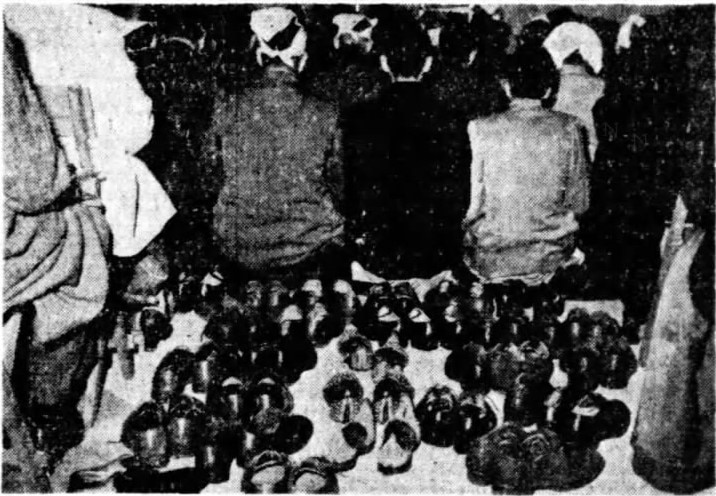
An Australian newspaper published a photograph captured during the Eid-ul-Adha prayer at the Fazl Mosque, with the following caption:
“Members of the Muslim Faith filled the London Mosque at Putney for the celebration of the Muslim Festival of Eid-ul-Adha. All footwear is removed before the congregation enter the mosque for the celebrations.” (The Morning Bulletin, 28 August 1954, p. 1)
1955: First-ever Eid led at the Fazl Mosque by a Khalifatul Masih
During his visit to Europe in 1955, Hazrat Musleh-e-Maudra led the Eid-ul-Adha prayer at the Fazl Mosque, on 30 July 1955. This was the first-ever Eid at the Fazl Mosque, led by a Khalifatul Masih and also the first-ever Eid-ul-Adha led in Europe by a Khalifatul Masih.
The total attendance was around 500, including various non-Muslim dignitaries, such as a Soviet attaché Mr Ivan Skripov, ambassadors of Argentina, Chile, Haiti, and the Dominican Republic; and Shaw Desmond (1877-1960) – an Irish author, spiritualist, and founder of the International Institute of Psychical Research. Moreover, Ald E Whitlock conveyed the greetings of the Wandsworth Rotary Club as well.
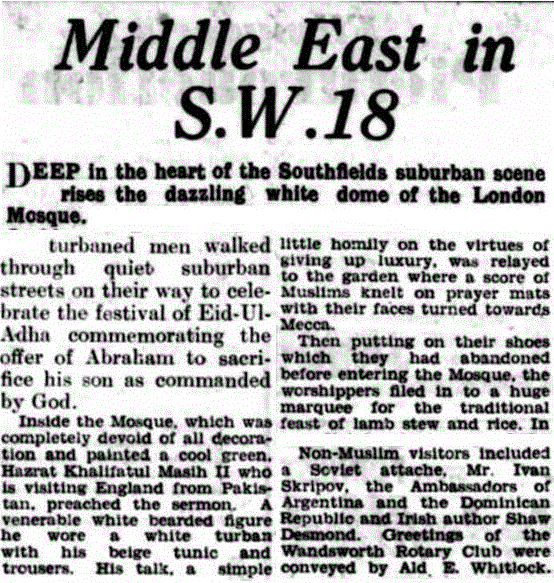
On 23 July 1955, The Civil and Military Gazette announced under the heading, “Id-ul-Azha in London”:
“At the London Mosque, Mirza Bashiruddin Mahmud Ahmad, head of the Ahmadiyya community, will lead the prayers.”
The Evening Standard of 30 July 1955 published a report under the heading “A Moslem Occasion”. The South Western Star of 5 August 1955 reported under the heading “Middle East in SW18”:
“Deep in the heart of the Southfields suburban scene rises the dazzling white dome of the London Mosque. […]
“Last Saturday,” scores of “fezzed and turbaned men walked through quiet suburban streets on their way to celebrate the festival of Eid-ul-Adha commemorating the offer of Abraham to sacrifice his son as commanded by God.
“Inside the Mosque, which was completely devoid of all decoration and painted a cool green, Hazrat Khalifatul Masih II[ra] who is visiting England from Pakistan, preached the sermon. A venerable white-bearded figure, he wore a white turban with his beige tunic and trousers. His talk, a simple little homily on the virtues of giving up luxury, was relayed to the garden, where a score of Muslims knelt on prayer mats with their faces turned towards Mecca.
“Then, putting on their shoes, which they had abandoned before entering the Mosque, the worshippers filed into a huge marquee for the traditional feast of lamb stew and rice. […]
“Non-Muslim visitors included a Soviet attaché, Mr Ivan Skripov, the Ambassadors of Argentina and the Dominican Republic, and Irish author Shaw Desmond. Greetings of the Wandsworth Rotary Club were conveyed by Ald E. Whitlock.”
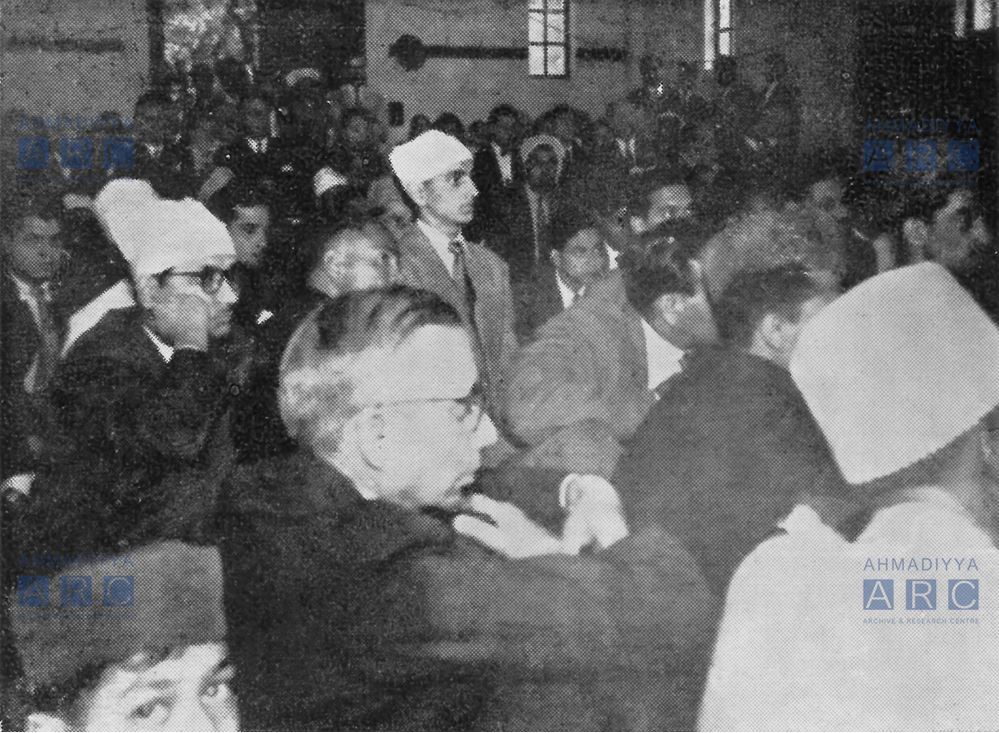
The Eastern World of September 1955 also gave a detailed report along with a photograph of Hazrat Musleh-e-Maudra.

